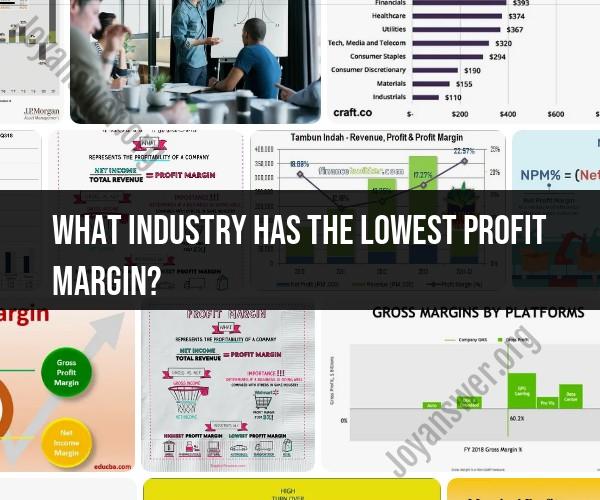What industry has the lowest profit margin?
Industries with the lowest profit margins typically face intense competition, high operating costs, and pricing pressures. Profit margins can vary widely within any industry, but here are some sectors known for having lower profit margins on average:
Grocery Stores and Supermarkets: Supermarkets often operate on thin profit margins due to fierce competition and the need to keep prices low to attract customers.
Restaurants and Food Services: The restaurant industry can have slim profit margins, primarily because of high labor, rent, and food costs.
Retail Apparel: Clothing retailers often have to deal with seasonal fluctuations, markdowns, and the need to stay competitive, which can affect profitability.
Electronics Retail: Electronics stores may face price competition and the need to keep up with ever-evolving technology.
Automotive Dealerships: Car dealerships may have lower margins on new car sales, with higher profits coming from service and used car sales.
Discount and Dollar Stores: These retailers offer low-cost products and often have low profit margins to maintain their price points.
Online Retail: While e-commerce can be profitable, intense competition, shipping costs, and the need for frequent promotions can lead to lower profit margins for some online retailers.
Airlines: Airlines often face high operating costs, fuel price fluctuations, and competition, resulting in historically low profit margins.
Hospitality and Hotels: The hotel industry's profit margins can be affected by occupancy rates, location, and economic factors.
Agriculture: Farming and agriculture can have narrow profit margins due to weather-related risks, fluctuating commodity prices, and production costs.
Gas Stations: Gas stations tend to have slim profit margins on fuel sales, with most profits coming from in-store sales.
Warehousing and Logistics: The logistics and warehousing industry may have lower profit margins due to competitive pricing and overhead costs.
Manufacturing: While manufacturing covers a broad range of industries, some sectors face intense competition and pricing pressures that result in lower margins.
Wholesale and Distribution: Companies in the wholesale and distribution business often operate on low profit margins to stay competitive.
It's important to note that while these industries may have lower average profit margins, individual businesses within these sectors can still be profitable through effective cost management, differentiation, and other strategies. Profitability within any industry can vary greatly depending on various factors, including the specific business model, location, and market conditions.
Which industry typically has the lowest profit margins?
The airline industry is a prime example of an industry with low-profit margins. According to a recent study, the average profit margin for airlines was just 5.3%. This is due to a number of factors, including the high cost of fuel, the need to maintain a large fleet of aircraft, and the intense competition in the industry.
Other industries with low-profit margins include:
- Grocery stores
- Restaurants
- Retail stores
- Hardware stores
- Construction companies
- Transportation companies
- Healthcare providers
What factors contribute to the reduced profitability in specific industries?
There are a number of factors that can contribute to the reduced profitability in specific industries. Some of these factors include:
- High competition: Industries with high competition tend to have lower profit margins. This is because businesses in these industries are constantly competing with each other to lower prices and attract customers.
- Low barriers to entry: Industries with low barriers to entry tend to have lower profit margins. This is because it is relatively easy for new businesses to enter these industries, which increases competition and drives down prices.
- High cost of goods sold: Industries with a high cost of goods sold tend to have lower profit margins. This is because the cost of goods sold is a direct expense, which means that it reduces the amount of money that a business has left over after paying all of its other expenses.
- Government regulation: Industries that are heavily regulated by the government tend to have lower profit margins. This is because government regulations can increase the cost of doing business and reduce the amount of money that a business has left over.
How do businesses in low-margin industries sustain their operations and growth?
Businesses in low-margin industries can sustain their operations and growth by focusing on the following:
- Efficiency: Businesses in low-margin industries need to be very efficient in order to be profitable. This means finding ways to reduce costs and improve productivity.
- Scale: Businesses in low-margin industries often need to achieve a certain level of scale in order to be profitable. This means increasing their sales and market share.
- Differentiation: Businesses in low-margin industries need to find ways to differentiate themselves from their competitors. This can be done by offering unique products or services, or by providing superior customer service.
By focusing on these factors, businesses in low-margin industries can sustain their operations and growth, even in challenging economic conditions.
Here are some additional tips for businesses in low-margin industries:
- Focus on your core competencies. What are you really good at? Focus on those activities and outsource or eliminate anything else.
- Find ways to add value to your products or services. What can you offer that your competitors don't?
- Build strong relationships with your customers. This will help you to retain customers and generate repeat business.
- Manage your costs carefully. Every penny counts in a low-margin industry.
- Be innovative. Look for new ways to do things and new markets to reach.
By following these tips, businesses in low-margin industries can increase their chances of success.



